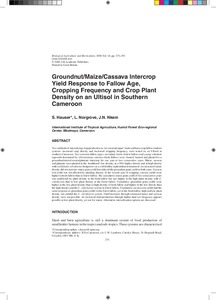| dc.contributor.author | Hauser, S. |
| dc.contributor.author | Norgrove, L. |
| dc.contributor.author | Nkem, J. |
| dc.date.accessioned | 2019-12-04T11:18:37Z |
| dc.date.available | 2019-12-04T11:18:37Z |
| dc.date.issued | 2006 |
| dc.identifier.citation | Hauser, S., Norgrove, L. & Nkem, J. (2006). Groundnut/maize/cassava intercrop yield response to fallow age, cropping frequency and crop plant density on an Ultisol in southern Cameroon. Biological Agriculture & Horticulture, 24(3), 275-291. |
| dc.identifier.issn | 0144-8765 |
| dc.identifier.uri | https://hdl.handle.net/20.500.12478/3267 |
| dc.description.abstract | Two methods of intensifying crop production in ‘no-external-input’ slash and burn crop fallow rotation systems: increased crop density and increased cropping frequency, were tested on an Ultisol in southern Cameroon. Two common fallow types, secondary forest (forest fallow) and young volunteer regrowth dominated by Chromolaena odorata (bush fallow) were cleared, burned and planted to a groundnut/maize/cassava/plantain intercrop for one year or two consecutive years. Maize, cassava and plantain were planted at the ‘traditional’ low density, at a 30% higher density and at high density with Calliandra calothyrsus hedgerows as a soil fertility replenishment treatment. An increased maize density did not increase maize grain yield but reduced the groundnut grain yield in both years. Cassava root yield was not affected by planting density. In the second year of cropping, cassava yields were higher in bush fallow than in forest fallow. The cumulative maize grain yield of two consecutive years was unaffected by plant density in the bush fallow but was higher in the high plant density with C. calothyrsus than in low plant density in the forest fallow. Cumulative groundnut grain yields were higher in the low plant density than in high density in bush fallow and higher in the low density than the high density and the C. calothyrsus system in forest fallow. Cumulative cassava root yields had the same response as groundnut grain yields in the forest fallow, yet in the bush fallow, high and low plant density out-yielded the C. calothyrsus system. Yield increases through increased maize and cassava density were not possible. An increased total production through higher land use frequency appears possible at low plant density, yet not for maize. Alternative intensification options are discussed. |
| dc.language.iso | en |
| dc.subject | Maize |
| dc.subject | Cassava |
| dc.subject | Groundnuts |
| dc.subject | Cropping |
| dc.subject | Grain |
| dc.title | Groundnut/maize/cassava intercrop yield response to fallow age, cropping frequency and crop plant density on an Ultisol in southern Cameroon |
| dc.type | Journal Article |
| dc.description.version | Peer Review |
| cg.contributor.affiliation | International Institute of Tropical Agriculture |
| cg.coverage.region | Africa |
| cg.coverage.region | Central Africa |
| cg.coverage.country | Cameroon |
| cg.isijournal | ISI Journal |
| cg.authorship.types | CGIAR single centre |
| cg.iitasubject | Maize |
| cg.iitasubject | Cassava |
| cg.iitasubject | Crop Systems |
| cg.iitasubject | Plant Breeding |
| cg.accessibilitystatus | Limited Access |
| local.dspaceid | 94941 |
| cg.identifier.doi | http://dx.doi.org/10.1080/01448765.2006.9755026 |

